143 Search Results for tabi
September 16, 2018
by Carole Zangari -

We’re wrapping up the week with a summary of posts. Here are some AAC posts you may have missed in your busy week. Monday – Building Your AAC SLP Toolkit: Obtaining Free Apps for AAC Evaluations Tuesday – AAC Link Up Wednesday – Video of the Week: Integrating AAC into the Classroom Thursday – Building AAC Facilitation Skills with Tabi Jones-Wohleber: MASTER PAL Training, Module 4 :::::::::::::::::::::::::::::::::::::::::::::::::::::::::::::::::::::::::::::::::::::::::::::::::::: Still have time for a little more reading? Here are some additional posts for you to explore. Beyond Requesting: Thoughts on Teaching Information Transfer How I Do It: Encouraging AAC Implementation (Lauren Enders) PrAACtical Ways to Make Decisions About Thematic Therapy Materials In the Treasure Bag: Using Sharing Time to Focus on Vocabulary AAC in Motion: Walk the Walk, Talk the Talk with Tanna Neufeld
September 9, 2018
by Carole Zangari -
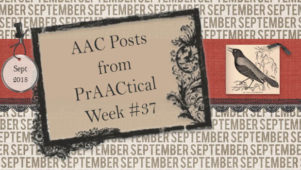
Well, hello, AAC friends! Thanks for checking in with us during your busy week. Here are some posts that may be of interest. Monday – On Labor Day Tuesday – AAC Link Up Wednesday – Video of the Week: Strategies for Helping Early AAC Users Engage and Interact Thursday – Building AAC Facilitation Skills with Tabi Jones-Wohleber: MASTER PAL Training, Module 3 ::::::::::::::::::::::::::::::::::::::::::::::::::::::::::::::::::::::::::::::::::::::::::::::::::::::::::::::::::::::::::::::::::::::::::::::::: Still have time for a bit more? Here’s a sampling of past posts for you to browse. PrAACtically Reading with Karen Natoci: Apples AAC Partner Training Strategies AACtual Therapy: From PECS to iPad with Jason Butcher 5 Things We’ve Learned from Our AAC Families Understanding and Supporting Families of AAC Learners
September 2, 2018
by Carole Zangari -
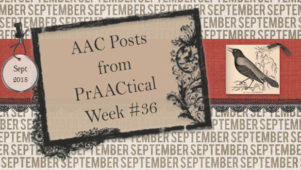
We’re saying goodbye to summer, and, heading full steam ahead into fall. Here are some posts from our prAACtical week. Monday – PrAACtically September: AAC Resources for a Year of Core Vocabulary Tuesday – AAC Link Up Wednesday – Video of the Week: Addressing the Social, Communication, and Behavioral Needs of Secondary Students with ASD using Visual Supports Thursday – Building AAC Facilitation Skills with Tabi Jones-Wohleber: MASTER PAL Training, Module 2 ::::::::::::::::::::::::::::::::::::::::::::::::::::::::::::::::::::::::::::::::::::::::::::::::::::::::::: If you have time for a bit more browsing, here are some posts you can explore. AAC Printables The Crust of AAC Every Second Counts Goodbye, Summer! A Clinician Prepares for a New School Year 3 Ways to Use AAC Goals to Strengthen Implementation
August 26, 2018
by Carole Zangari -
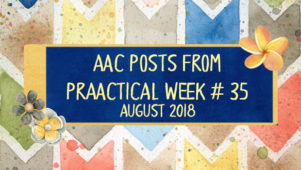
It’s a beautiful day to catch up on some AAC reading. Here are some posts from our prAACtical week. Monday – Letters from Camp, Day 1 Tuesday – AAC Link Up Wednesday – Video of the Week: AAC on the Move Thursday – Building AAC Facilitation Skills with Tabi Jones-Wohleber: MASTER PAL Training, Module 1 :::::::::::::::::::::::::::::::::::::::::::::::::::::::::::::::::::::::::::::::::::::::::::::::::::::::::::::: Still have an appetite for some AAC? Check out this sampling of past posts. SGDs for People with ASD “What Should I Program on the SGD?” Feature Match Chart 5 Features to Look for in SGDs and AAC Apps Making a Back-up for High-tech AAC :::::::::::::::::::::::::::::::::::::::::::::::::::::::::::::::::::::::::::::::::::::::::::::::::::::::::::::: Join us in January for a full day of preschool AAC! Use the slider on the right side of the graphic for more information. You can also download a PDF of it here.
January 16, 2018
by Carole Zangari -
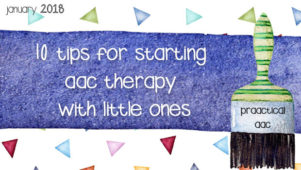
It’s exciting to see so many graduate student SLPs and new graduates who are interested in working with people with AAC needs. We hear from them frequently with questions about how to be effective in their therapy and the practical aspects of running a good therapy session. Here are some tips we frequently share with those who are starting to implement AAC with young children. Use a visual schedule for every session. The operative word there is ‘use.’ Making a schedule for our therapy is a great start, but unless we really use the schedule all throughout the session, it’s unlikely to provide many benefits. Go to it as soon as you get into the room, AND before and after every activity. (For those who are interested, there is more on making and effectively implementing visual schedules here. Trust the process. You will need to do this at least 4-8... [Read More...]
November 23, 2017
by Carole Zangari -

Here in the US, it’s a day of thanksgiving and that makes it a perfect time to express my gratitude for the contributions of our guest authors. It is amazing to look back and reflect on the contributions from families, therapists, and teachers, all of whom are incredibly busy. Special thanks to those who’ve come back time and time again to share their ideas, experiences, and resources in one of our recurring series. Vicki Clarke: AAC Assessment Corner and other topics Karen Natoci: PrAACtically Reading Jill Senner and Matthew Baud: How We Do It Amy Devin and Lauren Pawlowski: PrAACtical Teaching in the ASD Classroom Lauren Enders: PrAACtically Pinteresting, How I Do It, and more! Tabi Jones-Wohleber: How I Do It And others! I am grateful to all who make sharing what they know a priority and humbled that some of you choose to do it on PrAACtical AAC. Happy Thanksgiving,... [Read More...]
November 16, 2017
by Carole Zangari -
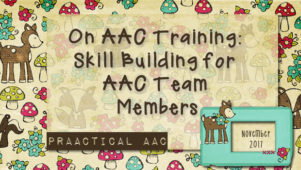
It’s throwback Thursday! Today, we are revisiting some prior posts on the topic of helping parents, colleagues, and classroom staff learn ways to better support people who use AAC. Explore these past posts to get ideas for videos, download presentation slides, and peruse suggestions for hands-on activities to use in your training. Enjoy! How I Do it: AAC Inservices by Tabi Jones-Wohleber Hands-On Activities for AAC Training PrAACtical Ideas: AAC Core Vocabulary Practice for Workshops and Inservices How We Do It: S’MORRES and Partner Augmented Input with Dr. Jill Senner & Matthew Baud Video Explainers for Aided Language Input
May 22, 2017
by Carole Zangari -
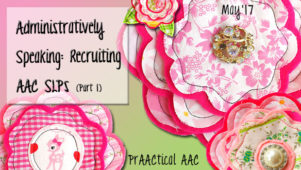
In a great many places, SLPs are in short supply. SLPs with specialized skills, such as those who can support students with AAC needs, are even harder to find. How can program administrators find, and, even more importantly, retain qualified SLPs? In this series, we share a few thoughts on the topic of space. One of the most meaningful things that an administrator is pretty simple: Ensure that the SLP has appropriate space in which to work. This basic requirement is frequently overlooked, particularly in educational settings. In schools, the SLP space is sometimes transient (e.g., M/W/F in the psychologist office, T/Th in the OT/PT area), inadequate (e.g., former book storage closet), or inappropriate (e.g., noisy environment, too small to hold groups). Sometimes, the space for SLP work is completely nonexistent. In the past few weeks, I’ve heard from SLPs who are expected to function without a dedicated workspace beyond... [Read More...]
March 30, 2017
by Carole Zangari -
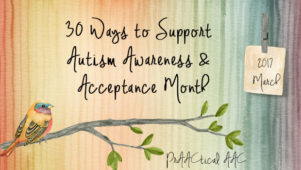
April is just around the corner and that means we’re getting ready to support the acceptance and inclusion of autistic people. Looking for ideas? Here are some to get you started. Treat yourself to some goodies from The Chocolate Spectrum (where you can order online, visit the cafe, or take a chocolate-making class) or other places that employ people with autism. Read and share 5 references that support the use of AAC & Autism. Help your family or community go beyond awareness and into acceptance. Learn and share information about Autism Safety – Be AWAARE! Know an autistic MineCraft lover? Introduce them to AutCraft. Educate yourself on terminology that relates to autism and people with ASD. We may have learned people-first language back in grad school, but there are different points of view on that. This is a great time to learn about identity-first language. Apply your critical reasoning skills to... [Read More...]
February 23, 2017
by Carole Zangari -
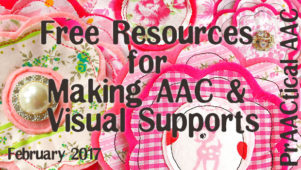
For comprehensive AAC systems, there is no doubt that we need access to tools with the communication symbols that match our client’s needs. There are times, though, when ‘free’ and ‘simple’ fits the bill. Whether you are a graduate student clinicians/teacher, parent, or professional, these tools may come in handy. Picto4Me: This executable program works with Google Chrome and allows you to create communication boards and other visual supports at no cost. You can view and use the boards online via computer or mobile device or print them. This program offers voice output and scanning, too. ARASAAC: We’ve written about the wonderful resources at the Aragonese Portal of AAC in previous posts. Keep them in mind as you are searching for symbols or creating AAC supports. Trial versions: Some companies offer a free trial of their symbol software or programs so that consumers can try before they buy. We love... [Read More...]









